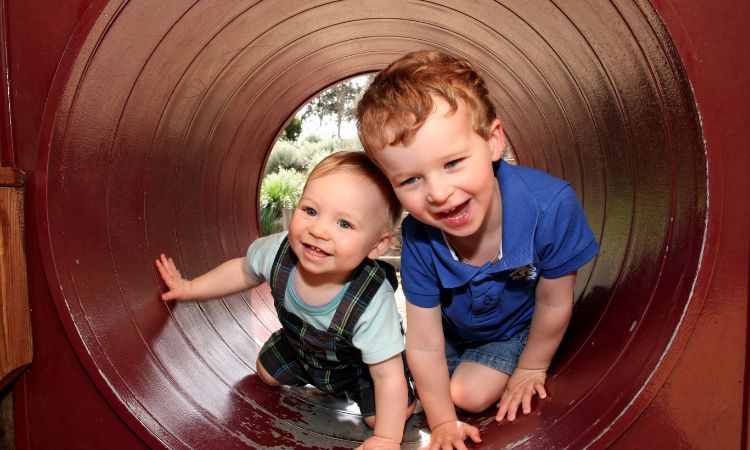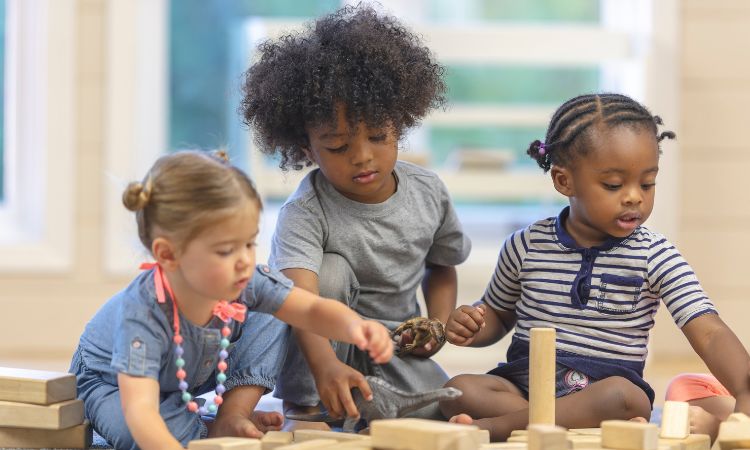Mixed age groups come with a set of benefits and challenges that educators need to navigate skilfully to foster a conducive learning environment. In this article, we share insights from ECT Niki Moodie and ECT/CELA facilitator Meg Anastasi, along with a beautiful reflection written by Niki Moodie.
Benefits of mixed age grouping
In 2019, the team at The Rumpus Room Chatham St observed that some of the older children at their service were seeking more freedom to play outdoors during the day.
“We wanted to find a way to give the children the flexibility they were seeking,” recalls Early Childhood Teacher Niki Moodie. “We have 68 children each day and while they’re technically enrolled in age-based rooms, they very rarely spend time just with their age group. By combining the whole centre in this way, where children group most often by friendships and interest, we found that all of the children could have what they needed, all of the time.”
Niki pointed out that playing and learning alongside children of different ages can have distinct benefits, including:
Social and emotional well-being
Mixed age groups can help to nurture empathy, social skills and emotional intelligence. Younger children are exposed to different perspectives from their older peers and the older children learn patience while helping their younger peers.
Emerging leadership
In mixed age groups, older children naturally find themselves in leadership roles. This not only aids in building their self-confidence but also fosters a sense of responsibility, nurtures positive behaviours and establishes a foundation for strong leadership skills.
Language development
Younger children are exposed to more advanced language use through their interactions with older children, facilitating a richer vocabulary and better comprehension skills.
Complex play
Mixed age settings typically lead to more intricate and multifaceted play scenarios. To navigate this, the younger children need to call on their critical thinking, creativity and problem solving.
“When you’ve got different age groups, you’ll often see the older children bringing the younger children into their play,” explains Meg Anastasi, CELA Training Facilitator and ECT at a service in Victoria. “The younger children are then in this learning rich environment where they’re extended further by their peers.”
Relationships between siblings
For many families, the appeal of mixed age groups is in keeping siblings together to help reduce separation anxiety.
It’s a lot easier for a child to transition into an environment with someone they know and trust, adds Meg.
Mixed age groups can offer a nurturing ground to foster sibling relationships, encouraging deeper bonds through structured interactions. Despite the benefits, there are some potential challenges to be aware of.
“If you’ve got a child going to primary school next year and separating from their whole family for the first time, you may need to actively build resilience around that,” explains Meg.

Theoretical underpinnings
With mixed age groups, we see different theories of child development converging to facilitate a rich, multifaceted learning environment.
Drawing on Erikson's Psychosocial Theory, we observe children navigating through various stages, each bringing something unique to the collective learning environment. This aligns with Piaget’s Cognitive Theory where children, seen as active constructors of knowledge, thrive in environments encouraging exploration and cooperation.
Vygotsky's Zone of Proximal Development adds depth, where older children guide the younger ones in tasks slightly beyond their reach, enhancing cognitive development and fostering a nurturing atmosphere. This approach promotes a deeper understanding of tasks and nurtures a collaborative and empathetic learning environment.
Implementation of mixed age grouping
Niki says the success of their approach comes down to working cohesively as a team. They take a collaborative approach with open communication and develop their ratios across the service, rather than by room.
| The ACECQA ratio checker is a tool services can use to help calculate appropriate ratios. Niki admits that they evolved as a service over time rather than an instant change to mix aged groups. |
“In centres of all sizes, it’s really important to accept that there will be challenges and obstacles. We started with combining two age groups – 3-4 and 4-5 – first and then added another age group until the mixed-age approach applied across the whole centre.”
Other considerations are ensuring that the physical environment and curriculum are dynamic to cater to the diverse needs of the different age groups. At The Rumpus Room, they have a large, shared outdoor area they call ‘the backyard’. Indoors, they ensure safety through communication to ensure the children are supported.
As for the curriculum, Niki says they take a child-led approach.
“The children come together based on their interests,” she explains. “We try not to force anything on the children so it’s very choice-driven and child-led with lots of opportunities for vicarious play and learning.”
Stepping stones
At The Rumpus Room Chatham St, Niki explains they took a staged approach that she admits is still evolving, even four years later.
“It took us three attempts at an indoor/outdoor program before we found a way that worked well for us,” she adds. “We had to change our mindset and remind ourselves that there are opportunities for intentional teaching in every moment during the day.”
It’s a collaborative journey, filled with learning opportunities for both children and educators. If done well, mixed aged groups can foster a rich, nurturing and dynamic learning environment that paves the way for holistic development.

What does mixed-age grouping in a forward-thinking, research driven long-daycare setting look like?
Reflection by Niki Moodie
IT LOOKS LIKE:
An open-plan preschool space, where children are free to roam through all four classrooms, and through the unobstructed playground.
Five year olds riding bikes with toddlers sitting in the passenger seat.
Babies watching their older siblings climb the balance rope to ring the bell at the top of the pergola, engaging in vicarious play.
Preschoolers placing a block next to a bench and holding a little one’s hand while they climb up so they can join in the play.
Brothers, sisters, cousins, neighbours, family friends playing with the ball together on the grass.
Four year olds slowing down their pace while they ‘race’ trucks with the two year old next to them.
Big long legs slowing themselves down on the swing when a baby toddles a little too close; contrasting levels of awareness of those around them.
Babies, snuggled in teachers laps, watching the big kids flying high on the swing.
One year olds watching five year olds engaging in adventurous play and following in their footsteps with confidence.
Babies and preschoolers going on excursions together, sharing in the experience, and engaging so beautifully with one another.
Four year olds heading to the baby room for some quiet time when they need to, going back to their old classroom and their old teachers for a cuddle.
A baby’s favourite person being the toddler room leader.
Just changing the nappy whether it’s your turn or not.
Preschool staff jumping into the baby room when they need a hand.
Every teacher knowing every child.
Constant reflection and discussion, and flexibility to make change when needed.
Children transitioning to a new room but barely needing to transition at all.
Staff working to strengths and interests, rather than the age group they’re assigned to.
Children gathering based on common interests.
Children and staff having agency and a deep sense of belonging and love for one another.
It looks like family.
|